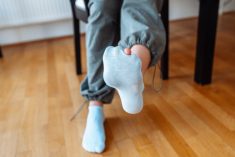A fitness rumour that is often heard is, “running isn’t good for you.”
Is it true? The short answer is — no — running is not bad for you.
However, using running as your only form of cross-training does have the potential for harm. Running without a planned-out strategy will likely end in burnout and pain. Running with uncorrected muscle imbalances will indeed lead to injury.
Running at its purest form is an excellent and age-old way to get cardio work in. If you correct any postural imbalances you have, run appropriately for your goals, and do appropriate mobility/strength training along with your running program, running should not cause you an issue, or impact your health/performance negatively.
Read Also

Gentle treatments for pain in the neck
Heading toward year-end, people unknowingly tense up against the cold and busyness, causing neck pain that can often be treated with appropriate support and gentle mobility, athletic therapist Kathlyn Hossack says.
Injuries and pain arise in running when the biomechanics aren’t in order. With running, the most common imbalances are decreased hip stability, poor foot activation, and poor breathing technique.
When hips aren’t stable, other muscles around the hips will attempt to take over pelvic stability. With this we see a tightening of the hamstrings, glutes, and hip flexors. There also tends to be an increase in knee pain. In addition to this, many use the popular highly cushioned and supportive shoes or some will go for the minimalist/barefoot trends.
Neither are necessarily great. Shoes are designed to protect our feet, but nowadays, they are marketed to do much more. The truth behind this is that the more “supportive” and cushioned a shoe is advertised as, the more likely it is to just turn off your foot’s natural activation and cause postural issues elsewhere.
You may be wondering about flat feet. With a little bit of effort you can correct most foot postural issues (like flat feet) yourself, for free. This doesn’t mean that you should be ditching all footwear and running barefoot, either. While running in minimalist-style footwear is something I may suggest for some people, it is only after they’ve gone through a rigorous postural correction program to find and fix any imbalances, and then slowly worked down to a minimalist level of footwear for training (both running, and otherwise).
Before you start running, it’s important to take time to do some hip stability work and foot reactivation through exercises.
It’s important to maintain cardio, and running offers a great way to build in that training. Walking has just as many health management benefits, but you may also like to give running a try.
If you’re new to running, start with low distance/intensity and build up tolerance. Unless your goals include marathons, running a few days a week is all most of us need in our training program.















